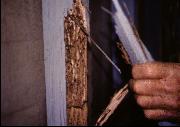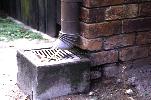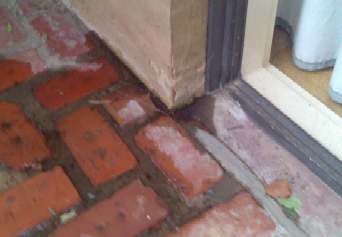Questions about doing it yourself
- 1. DIY
Trust and confidence need to be established. Will this pest manager do a good, competent job at a fair price? There are some slick and very shonky sales people out there ready to rip you off. There are honest pest managers who just want to give you a good job at a fair price. There are big companies and small companies, caring companies and careless companies. How can you decide who to employ?
Here's a few simple pointers. I hope they help.
- The Need: Don't be rushed. Chances are you have plenty of time to consider your options. Termites work slowly and so may you. Take your time and make the right choices. Consider how you know what you know. Keep notes of all conversations and keep your paper trail.
- The Business: The preferred way to find the right business is by talking with your friends and finding out who they have used successfully. Word-of-mouth keeps many successful businesses thriving.
How secure is the business?
Does it have a bad name?
Are they afraid to answer your questions?
Does the mention of their name ring alarm bells at your local consumer advocacy/complaints group?
Can they provide the names of satisfied customers as referees?
Don't necessarily feel that big is better; an apparently large company may turn out to be just loosely controlled franchises, offering at best no better service than their smaller competition.The quality of the job will only be as good as the person who carries it out. Will the person actually doing the work be well trained and knowledgeable and able to talk with you or are you dealing with a salesperson who can only provide the quotation?
- Face to Face: Meet them on your own turf, not their's. Depending on the nature of the problem, many pest controllers will provide a quotation either at no cost or fairly inexpensively. They may be prepared to just turn up and talk with you while requiring a fee before they'll do any inspection. This is fair, as any information they provide on the basis of inspection whether free or at cost, implies at least some professional responsibility and hence potential liability on their part. Beware the "free" inspection. Everything has to be paid for eventually, by somebody, sometime. Separate the inspection from the control proposal. Make sure that you get a proper (on paper) timber pest inspection (WDO, or 'Wood Destroying Organism") report and make sure that it identifies the pests as far as possible.
- Safety in Numbers: Approach at least two or three businesses. Compare their advice and quotations. Decide whom you would best trust with your assets. Then compare prices. Beware the surprisingly cheap quotation. It is easy to do a cursory inspection and to excessively dilute any expensive chemicals, or just not apply them where they should go. Remember the value of a good warranty. Read Claire's experience. Know the different ways termites can be managed and why the one proposed is thought best for you.
- The Fine Print: What does the paperwork look like?Ask to see it up front. After an inspection, you should be handed a written report, usually with a site diagram and the problem areas at least approximately mapped. The information should be clear. If it is presented on a preprinted form, the notations should be informative and quite clear. Look over the warranty. How small is the fine print? Do they mind you reading the contract? Is the scope of work made fully clear and is sufficient detail present to enable you to compare and contrast the quotes? Ideally, you will be asked to sign an agreement before any work occurs. That's a good way to ensure you have matching expectations.
- A Relationship?: What about contracts? Are you just getting them to fix today's problem or are you signing up for a never-ending dependency? What if you sign and you don't want them back again? What if termites come back in one, two or three years? What will they do then? If they've done good work, should you pay a maintenance fee for the year on top of the other costs? It is always important to check value for money. Maybe that service contract is aimed more at maximising income rather than minimising termites? You have to work it all out. There's often comfort in a trusted name, but you should put at least as much weight on local people's experiences as you do on brand recognition. Don't get me wrong, sometimes service contracts are the way to go, especially with a baiting program where you want it all planned out and costed in advance.
- Deciding: Take some time to think over the information you have gathered. One of the best ways is to get out of the house/office and go for a walk. You'll think much more clearly.
Vic Health has some good ideas and in Illinois, so does the Department of Public Health. Hope this helps. Please feel free to email me with your experiences.
Simple ways to avoid meeting termites
In the wild, pest termites usually get by quite happily eating sickly trees or the leftover bits of trees, and the safest, moist and tasty bits are usually underground or right in the middle of big pieces of timber. If your home/building/structure has big bits of wood that are dark or damp or close to the soil then your chances of avoiding termite problems are reduced.

Subterranean & dampwood termites
Subterranean termites usually get about by tunneling underground and entering their food from below. Tree roots are usually attached to trees and termites often travel from root to root great distances underground (there's almost always a small air gap under a big root, so they don't even have to dig as much). Timber waste buried around buildings usually leads to better food inside. Sometimes the termites just fly in and start up a fresh colony, but tunnelling is more common, because big bits of damp wood suitable for nesting are more often outside, not in. Dampwood termites don't tunnel nearly as much but can fly in just as easily.
Since the termites are most likely to try to get in via the soil, there are some simple things you can do:
Control moisture:
- All types of termites need moisture. Keep your structure dry and well ventilated.

A free drink - Ventilate all possible subfloor areas and ensure the vents are kept free and clear. Make sure you wet areas inside (kitchen/bathroom/dungeon) are well vented. Wood can get wet, but must not stay wet.
- Fix all plumbing leaks. Particularly showers and baths. These often have leaks supplying constant moisture that makes the wood just right to be eaten.
- Check all gutters and down spouts, make sure that the water ends up well away from the house. Ideally down spouts should connect to stormwater drains. If you don't have these, at least redirect the water well away from the house. Down spouts which regularly splash near the structure may be supplying an irresistible source of moisture.

Biochemist's paving blunder - Avoid having gardens directly against walls--if you must do this, provide space for air movement between the vegetation and the wall and an inspection zone of at least 100 mm. Never have sprinklers wetting the soil near a building or deck. Termites have even been known to enter a building through branches touching walls.
- Make sure that any paving is angled to drain surface water away from the structure. You'd be amazed how often this is done wrong. Some people even build outdoor paving higher than the interior floor level . . . like in this photo of the paving around my house.
Be careful with timber in ground contact:
- Remove any timber or cellulose material stored on the ground beneath a suspended floor. That includes cardboard boxes and old newspapers, even cotton materials. Clean up any off cuts left during construction. The aim is to maximize the distance between termites and their potential meal.

Polystyrene - Don't store any firewood in ground contact. This attracts termites. It also prevents the wood drying properly and hence reduces the heat yield on burning (it takes energy to boil water). Set your firewood at least 100 mm above ground (a shelf ot trench-mesh sitting on cinder blocks is a cheap solution).
- Structural wood in ground contact should be either termite resistant or treated with a preservative. Better yet, cut it off and mount it on a metal stirrup set in concrete. High and dry is always best.
- Don't provide hidden entry points where temites can walk in unseen. Stucco can hide termite freeways and rigid foam slab-edge insulation can be a nightmare, providing termites with easy and secure tunnel space where you can't see them. Instead, provide an impervious inspection zone. Use long-life physical barriers in all new construction.

Hidden entry paths There's a trend in the USA now to have stone veneers in ground contact. All these concealing wall finishes create a major risk.
Drywood termites
Drywood termites can live in small pieces of wood so long as it is a little moist and not too hot or cold. They'll fly in and start their colonies right in that wood. Best way to keep them at bay is to disguise your timber.
- Too Dry:Keeping timber very dry will make it impossible for termites to live, but this is impractical in many tropical and coastal areas where the natural humidity is sufficient to keep the wood moist enough for drywood termites. Do what you can to keep timber as dry as possible.
- Disguised:If they don't know it is wood, they may not find it. Keep all exterior wood well coated with paint or varnish, especially the larger bits and at the joins and ends. Drywood termites begin their attack with just two termites. First the female selects a likely place to live and then pairs up with a male before they start tunnelling. So if you can make the wood unattractive, the termites won't even try. A bit of preservative can go a long way. If it doesn't taste good, the termites won't hang around.
- Inaccessible:If they can't get to the wood they can't eat it. Seal up any cracks or fissures (these make it easy for them to get in). Cover vents with fine mesh screening (about 0.8 to 1.0 mm openings--but remember, you may need to increase the vent size to make up for this restriction of air flow). Pay particular attention to the roof and wall frames.
Following these simple points will greatly reduce your termite hazard. Best of all is to design your structure to be termite resistant from the very beginning. Remember too, that regular inspections can locate termites before they do any major damage.
Detecting termites is hard because they like to hide
Termites are little white, soft-bodied weaklings. Termites avoid light and rarely come out into the open. Termite attack can escape anyone's notice for a very long time, which can be horribly expensive, not to mention dangerous. A lot of houses that collapse during hurricanes or earthquakes really break due to weakening by termites.
So, how are termites in houses detected?

1. Dumb Luck. Often termites are detected . . . .
- when the vacuum cleaner leaves a dent in the skirting board
- when someone makes a dent in the floor
- when the door falls off
- when termites fly (in huge numbers) inside the house
-

Termite mud spots when you notice strange bits of mud in the plasterwork
- when the light/fan in the toilet/laundry won't turn off
- when the wood in the window frames looks mottled through the varnish
- when you notice strange bubbles in the paint
- when you lie awake at night and wonder what those quiet noises might be
2. When Other Trades are . . . .
- repairing a springy floor
- fixing leaky plumbing
-

Living lawn mower working in the garden
- putting in new cupboards
- installing your home theatre
3. Regular Inspections . . . .
- when you look under the floor and see tell tale shelter tubes
- when you look near all the wet areas and notice bubbled or uneven surfaces
- when you crawl around in the roof space and the wood seems hollow
- when you look at all those wings you keep vacuuming away . .
- when you hire a competent someone to do the looking for you
Copyright © 1996-20016
OK, so you've found termites. Here's a quick step guide of what to do.
- Don't spray anything. Spraying just makes the rest of them go to where they're hard to find.
- Don't disturb them. Often it is cheaper to control them if they are undisturbed.
- Don't panic. Termites tend to work slowly, so you usually have time to act before things get noticeably worse.
- Read through these FAQ files so you have a good background knowledge.
- Don't call the first company you find in the phone book. Take your time, find a good inspector get a written report, then work out what to do.
- Do fix up the things that attracted the termites in the first place.
- Do remember to have another inspection scheduled to make sure that things are really fixed.
- Do consider regular inspections so you can catch any new attacks early.






